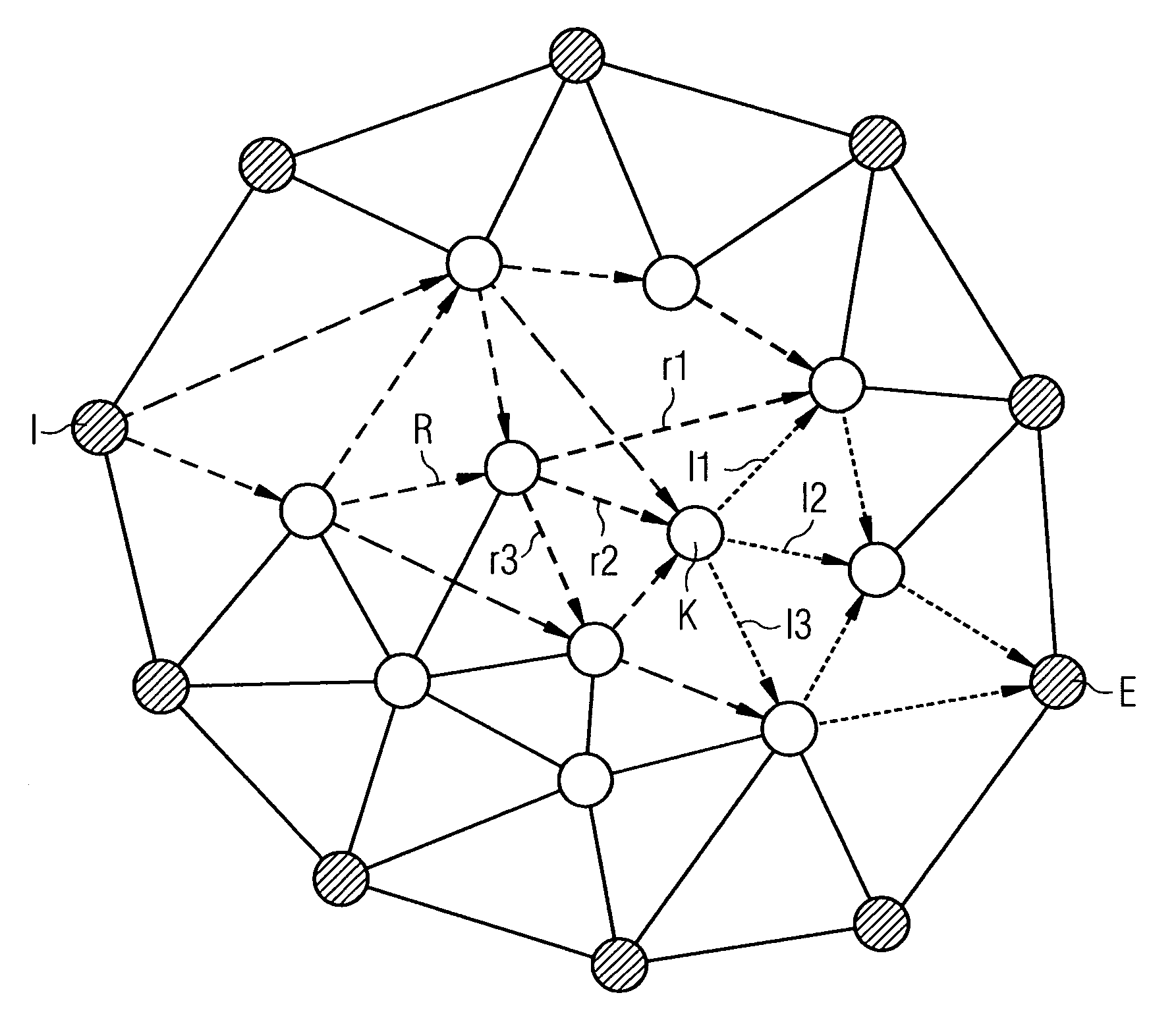[0004] An important approach to the transmission of real-time traffic via packet-based networks is the so-called DiffServ concept. In the context of this concept data packets entering a network are marked according to
class of service at the edge of the network and handled according to said
class of service when routed within the network. For the transmission of voice information, a corresponding
class of service can be assigned, so that the associated data packets are prioritized when routed within the network. This method allows real-time traffic to be handled during routing, giving this high-priority traffic better quality of service characteristics than in conventional IP networks. The relative quality of service corresponding to classified traffic improves. Absolute quality of service features cannot be guaranteed however. A relative improvement of traffic classes is inadequate in respect of the absolute limits to be complied with, such as a maximum
delay time for example during the transmission of voice information or a maximum
loss rate during the transmission of video data.
[0009] 1. To avoid overload situations within a packet network, the overall volume of traffic is restricted by monitoring inward and outward traffic at the edge of the network and applying a restriction when a threshold value is exceeded.
[0011] Restriction of the overall volume of traffic and the flexible distribution of traffic within the network allow the transmission of
data traffic via the network to be controlled, allowing quality of service features—e.g. compliance with specific limits—to be guaranteed with a high level of probability, if the parameters are selected appropriately.
[0013] The method according to the invention seeks to adjust distribution weights in a packet network made up of nodes and links. Traffic is thereby distributed in the packet network with the assistance of distribution fans. In a first method according to the invention to avoid overloading a network node, the entire
traffic load from the node or to the node is determined and verified to ascertain whether the overall
traffic load exceeds a threshold value. If the threshold value is exceeded, distribution weights at the links front-ending the node, which are associated with a distribution fan containing the node, are adjusted such that the traffic routed via the node is reduced. If for example a node front-ending the overloading node has three alternative outward links, which belong to the same distribution fan and lead to different nodes, the distribution weight of the two links that do not lead to the overloading node can be increased and the distribution weight of the link leading to the overloading node can be correspondingly reduced. This method can be implemented for all nodes in the packet network until the nodes are below the threshold value or an abort criterion is satisfied.
[0021] The methods according to the invention result in a rearrangement or adjustment of the distribution weights so as to achieve even traffic distribution. To be able to rearrange the distribution weights, the value of the distribution weights of nodes and links must first be initialized, i.e. initial values must be assigned. Expert allocation of initial values is important in respect of point convergence of the method, convergence referring to a value below the threshold value for all nodes or links. The distribution weights can for example be initialized by assigning initial values, with links associated with the same distribution fan and going away from or to a node being assigned a distribution weight according to their
relative bandwidth for the node. This allocation of initial values can be further improved by making a relative adjustment to the distribution weights of a distribution fan according to the number of links within a distribution fan via which packets have to be transmitted from the links to a destination, so as to reduce the number of links. This improvement aims to reduce the distance within the network, along which traffic is routed in the packet network. It is clearly expedient within a distribution fan, which establishes the possible path alternatives for traffic associated with permanent ingress and egress nodes, to prefer the paths or routes, which pass through the fewest possible links. Reduction of the distance covered in the network leads to a reduction in the
traffic volume in the network, with the overloading of individual links having to be avoided, which is ensured by the introduction of a threshold value.
[0022] It is also expedient to verify the overall load in the packet network as well, in order to select out beforehand situations in which the methods according to the invention do not converge for overall load. When verifying the overall load in the packet network, all the traffic entering the packet network via the
edge node and leaving via said
edge node is determined for example for each
edge node in the network. This can for example also be done with the assistance of the traffic matrix. Then all the traffic entering or leaving via the edge node of the network is compared with the value of the bandwidth of all the links from the node or to the edge node multiplied by a factor. The factor is thereby a number between 0 and 1. The method is aborted if all the traffic entering or leaving via the edge node of the network exceeds the total bandwidth of the links from the edge node or to the edge node multiplied by the factor between 0 and 1. This allows situations to be avoided in which a traffic overload occurs at edge nodes, which could also result in an excessive overall volume of traffic within the network.
 Login to View More
Login to View More  Login to View More
Login to View More 

